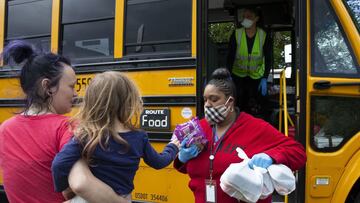CHILD TAX CREDIT
How has the Child Tax Credit impacted hunger in the United States?
New data shows the first payment of the Child Tax Credit cut child hunger by 3%. Our team took a look at the other impacts the credits had on households.

Millions of families across the United States have -- or will soon -- receive their second child tax credit payment.
With the delta variant leading to a surge in covid-19 cases, jeopardizing the economic recovery, the payments could not have come at a more critical point for many households.
However, even before the pandemic, one major issue that caused hardship across the United States was often ignored: childhood hunger. Feeding America, a non-profit food bank network, has reported that nearly 12 million children in the US face food insecurity. To address this issue and reduce child poverty more generally, the US Congress passed the American Rescue Plan, which included an expansion of the Child Tax Credit (CTC).
According to a hunger alleviation organization, BREAD, before CTC was expanded, “an estimated 27 million children under age 17 lived in families who did not earn enough to qualify for the full CTC for children because they did not have sufficient taxable income.” Many of these children and their families experienced hunger and food insecurity.
However, new research from US Census Bureau shows that the first payment of the CTC cut rates of hunger across the US historically. The data, released late last week, “show an overall decline in the share of adults in households experiencing food insufficiency (sometimes or often not having enough to eat), the drop was largely driven by adults in households with children.”
The Census Bureau collected the data through the Household Pulse Survey (HPS) conducted every two weeks. The HPS asks respondents the same set of questions to different households over a two-week period and then compares the changes in responses to identify trends.
Earlier this year, HSP data was used to break down how stimulus checks had improved economic stability, mental health, and more.
How did the CTC payment impact food insecurity?
According to the data, before the first CTC payment was sent on 15 July, around eleven percent of households with children were suffering from food insecurity. After the payments were made, the HPS tracked a three percent decrease in that rate. While this figure may seem small, it actually represents around 24% of households.
Experts can, in part, attribute the decrease in food insecurity to the CTC payments as levels for those without children, and all adults more generally remained the same.
Respondents who received the CTC were asked how they chose to spend the money. Around 47 percent of those surveyed reported spending it on food, and “nearly 10% of adults in households that received the CTC — and 17% of those with at least one child under age 5 — spent their CTC on child care.”
How else have the payments helped households with children?
The Census Bureau also saw a drop in levels of economic hardship.
To get an understanding of how households are holding up economically, the HPS asks respondents, “how difficult it was to pay their usual household expenses in the previous week.”
While before and after the first payment, the survey found that “adults in households with children were more likely to say that it was somewhat difficult or very difficult,” some improvements were found in the latter results. While economic hardship increased in households without children, the rate for those with dropped from 31.5 percent to 29 percent.
BREAD has also released information about how the CTC will impact child poverty rates, should the IRS register low-income families. According to the NGO, the expanded CTC could cut rates of poverty for:
- Asian American and Pacific Islander children by 37 percent,
- White children by 39 percent,
- Latino children by 45 percent,
- Black children by 52 percent, and
- Native American children by 62 percent.
When is the next payment coming?
Similar decreases to those seen after the first payment of the CTC were seen after the federal government sent each stimulus check. However, as the CTC payments will be reoccurring through the end of this year, experts hope that levels of hardship will decrease more sustainably in the coming months.
The IRS sent the second round of payments on 13 August.
The third CTC payment will be made on 15 September, and at that point, researchers will have more data and thus a better understanding of how these credits impact both food security and economic hardship.
- Joseph Biden
- IRS
- Crisis económica coronavirus Covid-19
- Ciencia
- Coronavirus Covid-19
- Crisis económica
- Hambre
- Estados Unidos
- Impuestos
- Hacienda pública
- Pandemia
- Coronavirus
- Recesión económica
- Norteamérica
- Tributos
- Coyuntura económica
- Virología
- Epidemia
- Enfermedades infecciosas
- Finanzas públicas
- Enfermedades
- Microbiología
- América
- Medicina
- Economía
- Finances
- Biology
- Health
- Society
- Life sciences






